The Zigzag pattern can be knitted using several techniques and will look different in each. It is made with both single-color threads and yarn of different shades. Pattern diagrams are used when knitting clothes, blankets, decorative items. Descriptions of the technique for working with each type of pattern differ, but they are all easy to perform if you practice a little.
Conventional symbols in instructions
In the description of the Zigzag pattern diagrams, conventional designations of the names of loops are used, which are used when knitting:
- P – loop;
- R – row;
- LP – front loop;
- IP – purl loop;
- KrP – edge loop (the first loop in a row is removed without knitting, the last one is performed as an IP).

Additional types of loops are described in master classes.
Classic Zigzag pattern
The Zigzag knitting pattern (the diagram and description is also called the Shavron motif) in the classic version is knitted from a pattern where 2 elements are constantly repeated. The rapport can be any: the number must be divisible by 2 and not less than 8.

Pattern diagram:
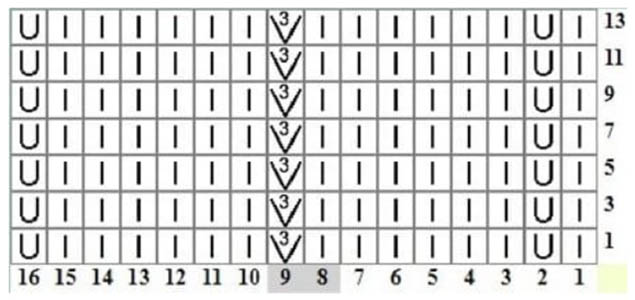
Classic Zigzag knitting pattern. Scheme and description
Explanation of symbols:
 | LP (front loop) |
| ND (yarn over) | |
 | УБ3 (decrease of 3 sts, knitted together as LP) |
For example, 19 sts are cast on to the knitting needles, and the pattern will be 16 loops:
- Cast on 19 sts: 16 for pattern, 1 for symmetry, 2 edge sts.
- 1 R: KrP, then rapport *1 LP, ND, 6 LP, UB3, 6 LP, ND*, 1 LP symmetry, KrP.
- 2 R: perform all loops according to the pattern: over the LP - front loops, over the IP - purl. All yarn overs from the previous row are knitted as IP.
- Repeat alternating rows 1 and 2 until the fabric reaches the desired height.
Advice. To make the central stripe of the rapport look even and neat, you need to knit the central loops according to the instructions: pick up the first 2 P of 3 from left to right (start the second, then the first), then knit the third loop as a LP, and then throw the 2 removed loops onto the knitted one. Thanks to this technique, the chain in the middle of the pattern will be even.
Classic Zigzag without holes in the fabric
The Zigzag pattern with knitting needles, the diagram and description of which do not differ from the classic version, in this case is knitted without holes at the base of the wedge in the motif. This knitting method is suitable if you need to knit a skirt, sweater or other things that should not be translucent.

The difference from the previous method of making the pattern is in the technique of knitting yarn overs. They are knitted as purl crossed loops.
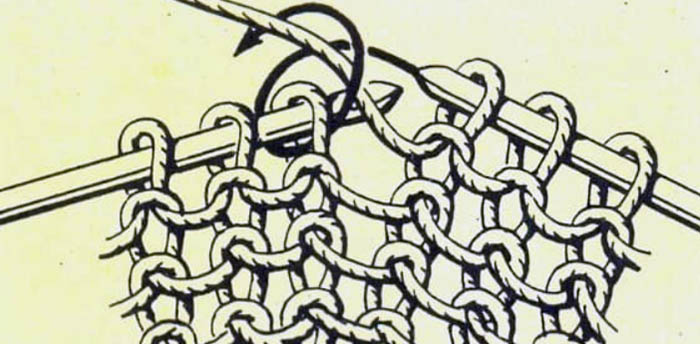
To do this, you need to pick up the yarn over from the outside, inserting the knitting needle from left to right behind the back wall, after which a classic purl loop is made.
Textured horizontal zigzag
The Zigzag knitting pattern, the diagram and description of which are easy to understand, is knitted by alternating 8 rows. The motif can be used to create textured hats, jumpers, outerwear. It is suitable for decorating home textiles: pillowcases, blankets, bedspreads, capes. The pattern resembles the texture of the fabric; it can be used for the entire canvas or for individual finishing elements.

To make a textured motif, cast on a number of stitches that is a multiple of 8 + 2 KrP. The pattern repeat in height is 8 rows.
Execution algorithm:
- 1, 2 R: all loops are worked as LP;
- 3 R: KrP, then perform the rapport until the end of the row *1 IP, insert the knitting needle as when performing IP, make a ND (turn around the knitting needle (Fig. 1)), pull out P to get ND, (Fig. 2), 1 IP*, KrP.
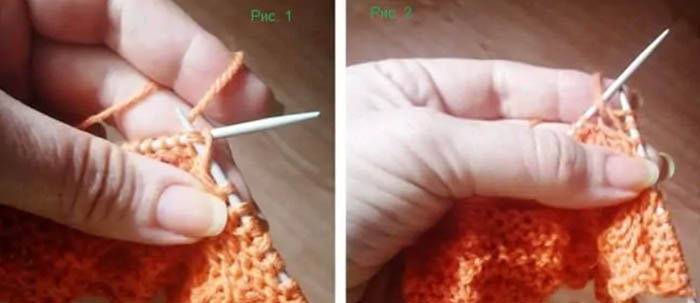
- 4 R: KrP, then perform the rapport to the end of the row *1 LP, transfer 6 P to the knitting needle on the right, unraveling the ND, return them to the knitting needle on the left, knit the 4th P from the transferred ones as LP (Fig. 3), picking it up from the front side and throwing it over the first 3 P (Fig. 4), knit the 5th P as LP and throw it over the first 3 P, do the same with the 6th P, knit these 3 P as LP and at the end perform 1 LP*, KrP.
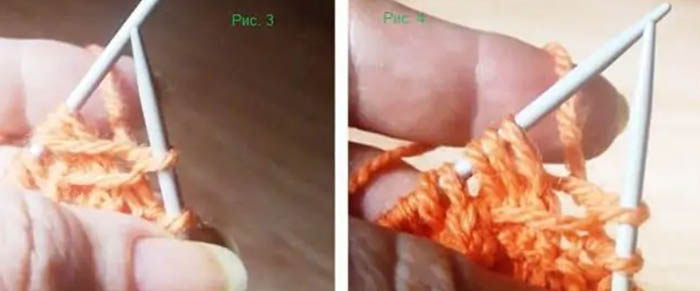
- 5, 6 R: knit all loops as LP.
- 7 R: KrP, 4 IP, then perform the rapport similar to the 3rd row. Without knitting the last 5 P before the end of the row, perform 4 IP, KrP.
- 8 R: KrP, 4 LP, then perform the rapport similar to the 4th row. Without knitting the last 5 P before the end of the row, perform 4 LP, KrP.
To knit a fabric of greater height, repeat the alternation of rows 1-8.
Zigzag with garter stitch as a base
The classic version of the pattern is made on the basis of stocking knitting. This version is based on the garter stitch technique. This is one of the patterns in the Missoni style. Its scheme is almost no different from the classic.

To knit a sample, you need to cast on 14 sts for the pattern rapport, 1 st for pattern symmetry and 2 edge loops, a total of 17 sts:
- 1 R: KrP, then rapport *1 LP, ND, 5 LP, UB3, 5 LP, ND*, 1 LP symmetry, KrP.
- 2 R: knit all loops as LP.
If you want the fabric to be free of holes, you should knit yarn overs on the back row using the technique of making crossed front loops. To do this, you need to pick up the yarn over from the outside, inserting the knitting needle from left to right behind the front wall, after which you make a classic front loop.
In this version of the pattern, it does not matter how you perform the 3 P rapports in the center, since with garter stitch there is no straight line in the middle.
Vertical zigzag
The Zigzag pattern with knitting needles, the diagram and description of which assumes the execution of only 2 standard types of loops, is difficult for beginners to knit in this case. The difficulty is not in the pattern itself, but in the alternation of loops. When working with this motif, you can easily get confused, then the pattern will turn out uneven. The peculiarity of the pattern is that the fabric is the same on both sides.
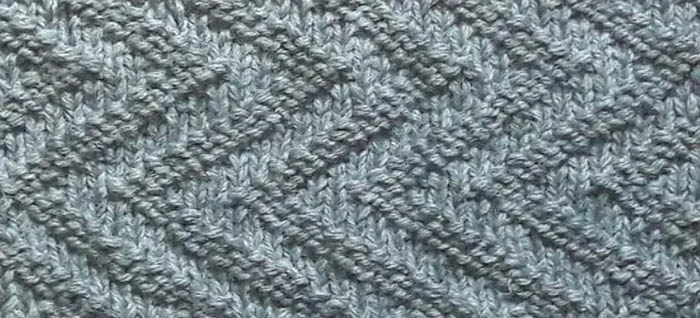
Knitting pattern diagram:

In the diagram, an empty cell denotes a purl stitch on the front side of the fabric and a knit stitch on the back side of the knitting. The vertical stripes, on the contrary, represent the LP in the front row and the IP in the back row.
The entire knitting pattern is based on alternately performing 3 LP and 3 IP to the end of the row. In the next row, the arrangement of the purl and front loops shifts by 1 P, but the alternation of 3 LP and 3 IP continues.
Vertical Corner Zigzag
The pattern repeat is 19 P + 2 KrP. The height of the motif is 32 rows.
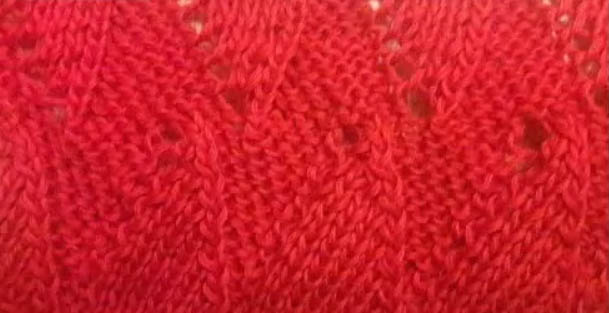
In addition to the usual LP and IP, the diagram contains 2 additional elements:
- УБл – knit 2 П together as LP with a left tilt;
- UBp – knit 2 P together as if to knit with a rightward tilt.
Knitting pattern sample diagram:
- Cast on 21 sts.
- 1 R: KrP, 1 LP, ND, UBl, 7 LP, ND, UBl, 7 LP, KrP.
- 2 R: perform all loops according to the pattern of the previous row: over IP – purl loop, over LP – front loop.
- 3 R: KrP, 1 LP, ND, 1 IP, UBl, 6 LP, ND, 1 PI, UBl, 6 LP, KrP.
- 4 R: perform all loops according to the pattern of the previous row.
- 5 R: KrP, 1 LP, ND, 2 IP, UBl, 5 LP, ND, 2 PI, UBl, 5 LP, KrP.
- 6 R: perform all loops according to the pattern of the previous row.
- 7 R: KrP, 1 LP, ND, 3 IP, UBl, 4 LP, ND, 3 PI, UBl, 4 LP, KrP.
- 8 R: repeat all loops according to the pattern of the previous row.
- 9 R: KrP, 1 LP, ND, 4 IP, UBl, 3 LP, ND, 4 PI, UBl, 3 LP, KrP.
- 10 R: perform all loops according to the pattern of the previous row.
- 11 R: KrP, 1 LP, ND, 5 IP, UBl, 2 LP, ND, 5 PI, UBl, 2 LP, KrP.
- 12 R: perform all loops without changes.
- 13 R: KrP, 1 LP, ND, 6 IP, UBl, 1 LP, ND, 6 PI, UBl, 1 LP, KrP.
- 14 R: perform all loops according to the pattern of the previous row.
- 15 R: KrP, 1 LP, ND, 7 IP, UBl, ND, 7 IP, UBl, KrP.
- 16 R: repeat all loops according to the pattern of the previous row.
- 17 R: KrP, 4 IP, UBp, ND, 7 IP, UBp, ND, 4 IP, KrP.
- 18 R: work all loops in the row without changes.
- 19 R: KrP, 3 IP, UBp, 1 LP, ND, 6 IP, UBp, 1 LP, ND, 4 IP, KrP.
- 20 R: perform all loops according to the pattern of the previous row.
- 21 R: KrP, 2 IP, UBp, 2 LP, ND, 5 IP, UBp, 2 LP, ND, 4 IP, KrP.
- 22 R: perform all loops without changes.
- 23 R: KrP, 1 IP, UBp, 3 LP, ND, 4 IP, UBp, 3 LP, ND, 4 IP, KrP.
- 24 R: make loops according to the pattern of the previous row.
- 25 R: KrP, UBp, 4 LP, ND, 3 IP, UBp, 4 LP, ND, 4 IP, KrP.
- 26 R: work all loops in the row without changes.
- 27 R: KrP, UBp, 4 LP, ND, 2 IP, UBp, 5 LP, ND, 3 IP, 1 LP, KrP.
- 28 R: perform all loops according to the pattern of the previous row.
- 29 R: KrP, UBp, 4 LP, ND, 1 IP, UBp, 6 LP, ND, 2 IP, 2 LP, KrP.
- 30 R: perform the row loops without changes.
- 31 R: KrP, UBp, 4 LP, ND, UBp, 7 LP, ND, 1 IP, 3 LP, KrP.
- 32 R: make loops according to the pattern of the previous row.
Then continue knitting according to the instructions from Rows 1 to 32.
Volumetric openwork zigzag pattern
The motif, reminiscent of waves, comes out in relief. It looks beautiful in color. The shade of the threads is usually changed in a chaotic sequence.
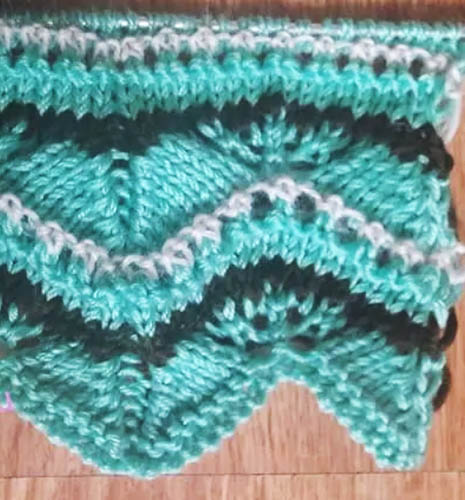
The pattern repeat is a multiple of 18 P. To these, 1 P is added for symmetry of the knitted fabric and 2 edge loops.
Knitting pattern algorithm:
- 1 R: KrP, then perform the rapport *1 IP, 2 P together as LP with a tilt to the right (UBp), 6 LP, ND, 1 LP, ND, 6 LP, 2 P together with a tilt to the left (UBl)*, perform the penultimate loop of symmetry as LP, KrP.
- 2 R: KR, then perform the rapport *1 LP, 2 P together crossed purl, 13 IP, 2 P together as IP behind the front wall*, 1 LP, KR.
- 3 R: KrP, then perform the rapport *1 IP, UBp, 4 LP, ND, 1 LP, ND, 1 LP, ND, 1 LP, ND, 4 LP, UBl*, 1 IP, KrP.
- 4 R: KrP, then perform the rapport *1 LP, 2 P together as crossed LP, 13 IP, 2 P together as IP behind the front wall*, 1 LP, KrP.
- 5 R: KrP, then perform the rapport *1 IP, UBp, 3 LP, ND, 1 LP, ND, 1 LP, ND, 1 LP, ND, 1 LP, ND, 1 LP, ND, 1 LP, ND, 2 LP, UBl*, 1 IP, KrP.
- 6 R: KrP, then perform the rapport *1 LP, 2 P together as crossed IP, 15 IP, 2 P together as IP behind the front wall*, 1 LP, KrP.
- 7 R: KrP, then perform the rapport *1 IP, 17 LP*, 1 IP, KrP.
- 8 R: make a pattern according to the drawing: above IP – purl loop, above LP – front loop.
- 9 R: repeat pattern of row 7.
- 10 R: work all loops as LP.
- 11 R: KrP, then perform the rapport *ND, 2 P together as LP*, 1 IP, KrP.
- 12 R: work all loops as LP.
- 13 R: repeat pattern of row 7.
- 14 R: make a pattern according to the drawing: above IP – purl loop, above LP – front loop.
Continue working in the same manner in height, alternating rows 1-14.
Horizontal zigzag with relief
This pattern comes out equally neatly on both the front and back sides of the fabric. The motif rapport is 10 P and 16 R. If necessary, you can change the height of the zigzag, proportionally increasing or decreasing the width of the teeth.
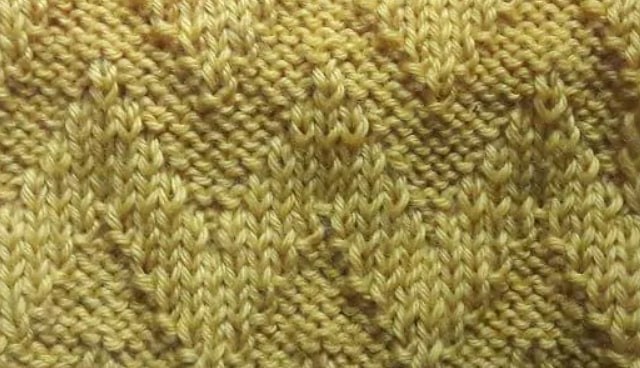
To knit a sample, you need to cast on 23 sts (20 sts for 2 rapports, 1 st for pattern symmetry, 2 sl sts):
- 1 R: KrP, then 2 times the rapport *1 LP, 4 IP, 1 LP, 4 IP*, 1 LP symmetry, KrP.
- 2 R: performed according to the pattern of the previous row: over the LP – front loop, over the IP – back loop.
- 3 R: KrP, then 2 times the rapport *2 LP, 7 IP, 1 LP *, 1 LP symmetry, KrP.
- 4 R: follow the pattern of the previous row.
- 5 R: KrP, then 2 times the rapport *3 LP, 5 IP, 2 LP *, 1 LP symmetry, KrP.
- 6 R: performed according to the pattern of the previous row: over the LP – front loop, over the IP – back loop.
- 7 R: KrP, then 2 times the rapport *4 LP, 3 IP, 3 LP *, 1 LP symmetry, KrP.
- 8 R: follow the pattern of the previous row.
- 9 R: KrP, then 2 times the rapport *1 IP, 4 LP, 1 IP, 4 LP*, 1 IP symmetry, KrP.
- 10 R: performed according to the pattern of the previous row: over the LP – front loop, over the IP – back loop.
- 11 R: KrP, then 2 times the rapport *2 IP, 7 LP, 1 IP*, 1 IP symmetry, KrP.
- 12 R: follow the pattern of the previous row.
- 13 R: KrP, then 2 times the rapport *3 IP, 5 LP, 2 IP*, 1 IP symmetry, KrP.
- 14 R: over LP – front loop, over IP – back loop.
- 15 R: KrP, then 2 times the rapport *4 IP, 3 LP, 3 IP*, 1 IP symmetry, KrP.
- 16 R: follow the pattern of the previous row.
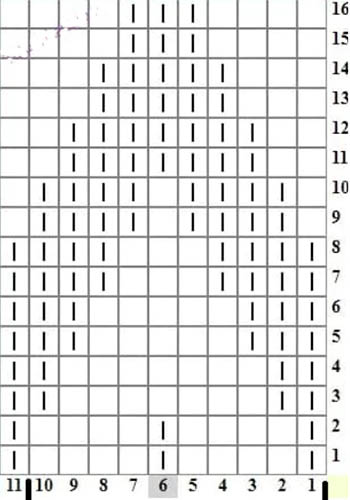
To continue knitting the pattern, begin repeating the pattern from rows 1 to 16.
Volumetric openwork zigzag
The pattern in this version is voluminous, but if you steam it, the fabric will become flat. In the first case, it is used to create scarves, snoods, and elegant vests. When steamed, it looks good on sweaters and cardigans.

To make the central strip of the rapport look even and neat, you need to knit the central loops according to the instructions: pick up the first 2 P of 3 from left to right (start the second, then the first), then knit the third loop as a LP, and then throw 2 removed loops on the knitted one. Thanks to this technique, the chain in the middle of the pattern will be even.
In addition to the usual LP and IP, the diagram contains 2 additional types of loops:
- УБл – knit 2 П together as LP with a left tilt;
- UBp – knit 2 P together as if to knit with a rightward tilt.
The pattern repeat is 23 sts and 12 rows. To knit the pattern, you need to cast on 25 sts, taking into account the edge sts.
Instructions for performing the motif:
- 1 R: KrP, 5 LP, UBp, ND, 1 LP, ND, 2 LP, 3 P together as LP (according to the instructions for the central chain of loops), 2 LP, ND, 1 LP, ND, UBl, 5 LP, KrP.
- 2 R: follow the pattern of the previous row: knit stitch over LP, purl stitch over IP.
- 3 R: KrP, 4 LP, UBp, ND, 3 LP, ND, 1 LP, 3 P together as LP (according to instructions), 1 LP, ND, 3 LP, ND, UBl, 4 LP, KrP.
- 4 R: knit over LP – front loops, over IP – back loops.
- 5 R: KrP, 3 LP, UBp, ND, 5 LP, ND, 3 P together as LP (according to instructions), ND, 5 LP, ND, UBl, 3 LP, KrP.
- 6 R: follow the pattern of the previous row.
- 7 R: KrP, 2 LP, UBp, ND, 1 LP, ND, 5 LP, 3 P together as LP (according to instructions), 5 LP, ND, 1 LP, ND, Ubl, 2 LP, KrP.
- 8 R: knit over LP – front loops, over IP – back loops.
- 9 R: KrP, 1 LP, UBp, ND, 3 LP, ND, 4 LP, 3 P together as LP (according to instructions), 4 LP, ND, 3 LP, ND, UBl, 1 LP, KrP.
- 10 R: performed according to the pattern of the previous row: over the LP – front loop, over the IP – back loop.
- 11 R: KrP, UBp, ND, 5 LP, ND, 3 LP, 3 P together as LP (according to instructions), 3 LP, ND, 5 LP, ND, UBl, KrP.
- 12 R: follow the pattern of the previous row.
Continue knitting the pattern, starting the alternation of rows again: from 1 to 12 R.
Textured motif
This pattern turns out to be openwork. Externally, it resembles disproportionate check marks. The motif is suitable for knitting elegant vests and sweaters. It is not difficult to knit.

The pattern repeat is 6 P and 8 R. First, you need to cast on a number of loops that is a multiple of 6 and another 2 edge loops.
Knitting instructions:
- 1 R: KrP, then the rapport is performed *3 LP, UBp, ND, 1 LP*, KrP.
- 2 R: KrP, then the rapport is performed *2 IP, ND, 2 P together as IP, 2 IP*, KrP.
- 3 R: KrP, then rapport *1 LP, UBp, ND, 3 LP*, KrP.
- 4 R: KrP, then make a rapport *4 IP, ND, 2 P together as IP*, KrP.
- 5 R: KrP, then make a rapport *1 LP, ND, UBl*, KrP.
- 6 R: KrP, then the rapport is performed *2 IP, 2 P together as a crossed IP, ND, IP*, KrP.
- 7 R: KrP, then rapport *3 LP, ND, UBl, 1 LP*, KrP.
- 8 R: KrP, then the rapport is performed *2 P together as a crossed IP, ND, 4 IP*, KrP.
Next, knit the fabric to the desired height, starting to alternate again from rows 1 to 8.
Smooth zigzag
This is a simple but beautiful motif, where the zigzag is made with smooth lines in the form of waves. The pattern repeat is 18 P and 14 R.

Instructions for completing the drawing:
- Cast on 20 sts (18 for the pattern and 2 edge sts).
- 1 R: KrP, then perform the rapport 6 times *2 P together as LP*, and another rapport also 6 times *ND, 1 IP*, KrP.
- 2 R: knit all loops as LP.
- 3 R: perform all loops as IP.
- 4 R: knit all loops as LP.
- 5-8 Rows: Knit as 1-4 Rows.
- 9-11 Rows: knit as 1-3 Rows.
- 12-14 R: knit all loops as LP.
When knitting, you need to make sure that the number of yarn overs and stitches knitted together is the same.
The zigzag pattern on knitting needles is often knitted in a single-color version. To create children's or youth items, yarn of 2-3 shades is used. Patterns for beginners may seem incomprehensible and confusing, so it is better to follow step-by-step descriptions in the process of learning to knit. Over time, experience will come, then it will be possible to perform the most complex patterns without hints.
Video about knitting Zigzag pattern with knitting needles
How to knit a zigzag pattern with knitting needles. Knitting lessons for beginners:
